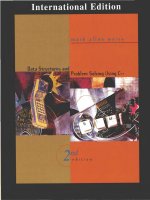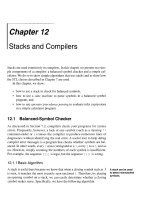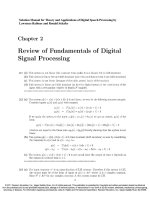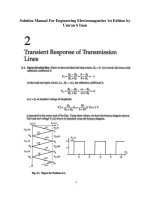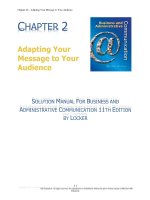link full download solutions manual data structures problem solving using c 2nd edition weiss
Bạn đang xem bản rút gọn của tài liệu. Xem và tải ngay bản đầy đủ của tài liệu tại đây (211.87 KB, 6 trang )
Solution Manual for Data Structures and Problem
Solving Using C++ 2nd edition by Mark A. Weiss
Chapter 1
Pointers, Arrays, and Structures
1.1
Key Concepts and How To Teach Them
This chapter introduces several concepts:
•
•
•
•
•
•
basic arrays (first-class arrays, using vector)
basic strings (using string)
pointers
dynamic allocation
reference variables and parameter passing mechanisms
structures
Depending on the students’ background, some or even all of this chapter
could be skipped, but I recommend at least a quick review of the chapter in all
cir-cumstances. Students who have not had C or C++ should go through the
entire chapter slowly. It is easy for students to think they understand the material
in this chapter based on an earlier course, and my experience is that they do not.
1.1.1
Arrays
Modern C++ arrays use the standard vector class and avoids the C-style array.
I like to explain the idea of using a library class, so as to lead in to Chapter 2.
Remind students that array indexing starts at 0 and goes to size()-1. Off-byone errors are very common; make sure the students are aware of these possibilities, and that the standard vector is not bounds checked (we write a better one in
Chapter 3). Explain parameter passing. Finally discuss the push_back idea. I
have found that push_back is easy for students to understand.
1.1.2 Strings
There is not much to do here; avoid C-style strings. You may
prefer to do strings
1.1.3 Pointers
Draw the usual memory pictures and emphasize that a pointer object is an object
that stores a memory address. Go through as many examples as you can to
distin-guish between accessing a pointer and dereferencing it. Note: The NULL
constant is defined in several header files, including stdlib.h.
1.1.4
Dynamic Allocation
This is here to avoid forward references in the text. You may prefer to delay this
material until linked lists are discussed. Or you can preview the idea of new and
delete, and explain the problems of stale pointers and double-deletion.
Explain the term memory leak.
1.1.5
Reference Variables and Parameter Passing Mechanisms
The key topic here is the distinction between call-by-value, call-by-reference,
and call-by-constant reference. Emphasize over and over again, that there are
really three forms of parameter passing and that the const is not merely
window dressing. Here are my rules:
• Call by value: used for IN parameters for built-in types
• Call by constant reference: used for IN parameters for class types
• Call by reference: used for IN OUT parameters
Many students insists on passing int objects by constant reference; this is
wrong! It induces the overhead of pointer indirection when the reference is
accessed inside the function.
Many students get confused about passing pointers. When a pointer object is
passed, the value of the object is an address. Passing a pointer by reference
means that where the pointer points at could change. This is useful for resizing
dynami-cally allocated C-style arrays and also in binary tree updates.
1.1.6
Structures
This is a quickie opener to the class discussion. A C-style structure achieves the
grouping of data, but does not provide for information hiding or encapsulation of
functionality. Even so, some issues become evident and are worth discussing:
1. Structures should be passed either by reference or constant reference.
2. Deep vs. shallow copy.
3. Quick introduction to the linked list, C-style.
1.2
Solutions To Exercises
In Short
1.1 Pointers can be declared and initialized, they can be assigned to point at an
object, they can be dereferenced, they can be involved in arithmetic. The
address-of operator can be applied to a pointer in the same manner as any
other object.
1.2 (a) Yes; (b) Both have the same value as A; (c) *ptrPtr=&b; (d) No;
these objects have different types.
1.3
(a) Yes as long as x is an object. (b) No, because x might not be a pointer.
1.4 (a) the address where a is stored; (b) the value of a (5); (c) 1; (d) this is a
type mismatch, and if accepted by the compiler is most likely 0; (e) the
address where ptr is stored; (f) illegal, because a is not a pointer; (g) the
value of a (5); (h) the value of a (5).
1.5
1.6
(a) a is a member of type int in struct S and b is a member of type pointer
to S in struct S; (b) z is of type S; (c) x is of type pointer to S; (d) y is of
type array of 10 S; (e) u is of type array of 10 pointer to S; (f) x->a is
of type int; (g) x->b is of type pointer to S; (h) z.b is of type pointer
to S; (i) z.a is of type int; (j) *z.a is illegal because z.a is not a pointer
type; (k) (*z).a is illegal because z is not a pointer type;
(l) (this question should not be here) x->b-z.b is a subtraction of point-ers
and is thus of type int; (m) y->a is illegal; (n) y[1] is of type S;
(o) y[1].a is of type int; (p) y[1].b is of type pointer to S; (q)
u[2] is of type pointer to S; (r) *u[2] is of type S; (s) u[2]->a
is of type int; (t) u[2]->b is of type pointer to S; (u) u[10] is of
type pointer to S but is past the declared bounds of u; (v) &z is of type
pointer to S; (w) &x is of type pointer to pointer to S; (x) u is of type
array of pointer to S; (y) y is of type array of S.
The picture below reflects a, b, and c after the declarations. The statement b=5 changes a to 5 and then c=2 changes a to 2.
b
a = 3
c
1.7 This is perfectly legal. However if the const is moved from the second
declaration to the first, then the declaration and initialization of b would be illegal.
1.8
/* begins a comment.
1.3
1.1.
Exam Questions
For the declarations below, which statement is illegal?
int *ptr1;
int *ptr2;
int a = 5;
a. ptr1 = ptr2;
b. ptr1 = a;
c. ptr1 = &a;
d. *ptr1 = *ptr2;
e. *ptr1 = a;
1.2.
For the declarations below, which expression is true if ptr1 and
ptr2 point at the same object?
int *ptr1;
int *ptr2;
a. ptr1 == ptr2
b. *ptr1 == *ptr2
c. *(ptr1 == *ptr2)
d. &ptr1 == &ptr2
e. None of the above
1.3.
For the declaration below, what is the type of *a?
const int *a;
a.
b.
c.
d.
e.
int
const int
int *
const int *
none of the above
1.4.
A memory leak occurs when:
a.
b.
c.
d.
e.
1.5.
Which of the following parameter passing mechanisms can be used to
alter a parameter?
a.
b.
c.
d.
e.
1.6.
Call by value
Call by reference
Call by constant reference
All of the above
None of the above
A shallow copy refers to
a.
b.
c.
d.
e.
1.7.
A local array is deleted.
A dynamically allocated object is deleted.
A dynamically allocated object is no longer referenced.
Two pointers point at the same object.
A dynamically allocated object is deleted twice.
the copying of small objects
the copying of pointers
the copying of objects that are being pointed at
the copying of basic types, such as integers
call by value
Exogenous data is
a. a small member of a structure
b. a large member of a structure
c. an object that is not part of the structure, but is pointed at by the
structure
d. a global variable
e. the entire structure
1.8.
If f is a member of structure S, and p is of type pointer to S, then
which expression must be legal?
a.
b.
c.
d.
e.
p.f
p->f
*p.f
s.f
More than one of the above
1.9. What is the result of the following?
int x = 5;
int & ref = x;
ref++;
a.
b.
c.
d.
e.
1.10.
It increments x
It increments ref
It increments *ref
It increments &ref
It is illegal
What is the result of the
following?
int x = 5;
int *ptr = &x;
int * & ref = ptr;
*ref++;
a.
b.
c.
d.
e.
It increments ptr
It increments ref
It increments x
It increments &ref
It is illegal
Answers to Exam Questions
1.
2.
3.
4.
5.
6.
7.
8.
9.
10.
B
A
B
C
B
B
C
B
A
A

